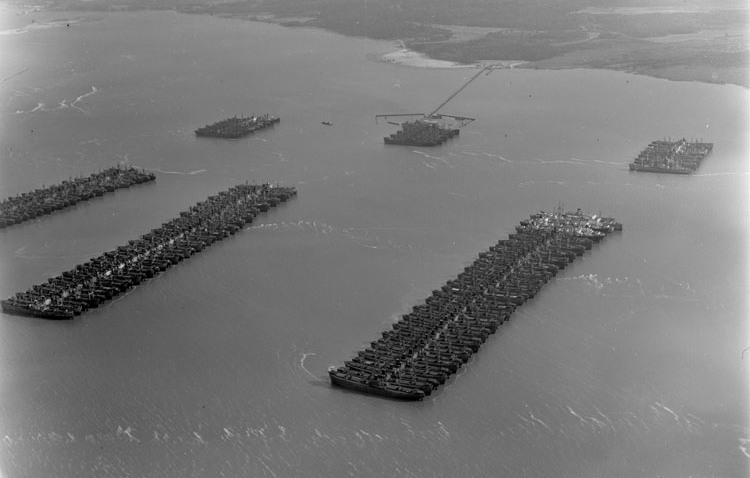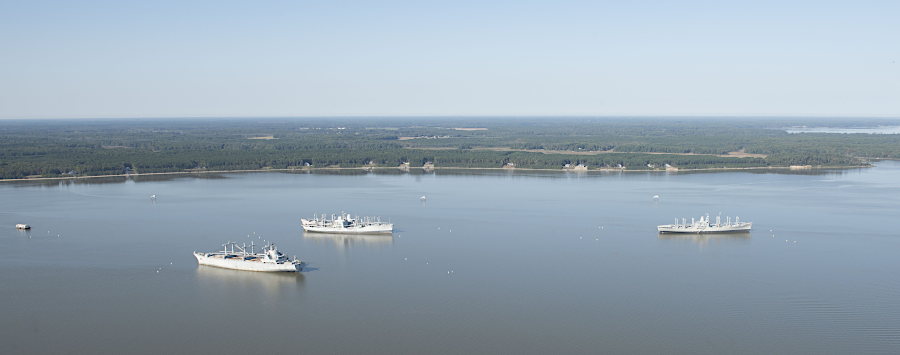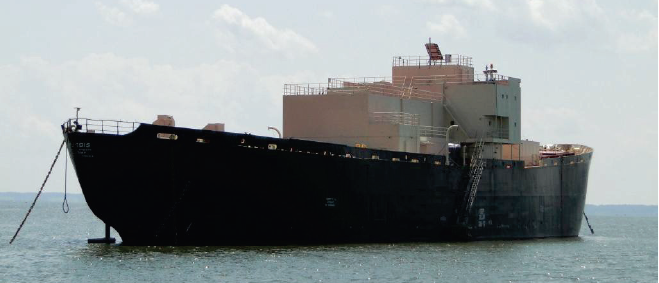
ships not needed after the end of World War II were mothballed and stored off Mulberry Point (Fort Eustis) in the James River
Source: Library of Virginia, Mothballed fleet

ships not needed after the end of World War II were mothballed and stored off Mulberry Point (Fort Eustis) in the James River
Source: Library of Virginia, Mothballed fleet
Shipping was disrupted by World War I. In response, the US Congress passed the Shipping Act of 1916. It created the US Shipping Board, the predecessor to the Maritime Administration (MARAD) which was created in 1950 and is now part of the US Department of Transportation.
The Shipping Board was given responsibility for promoting the US Merchant Marine and regulating commercial shipping. After the US Congress declared war on Germany on April 6, 1917, the Shipping Board created the Emergency Fleet Corporation to build ships to steam across the Atlantic Ocean. When the construction effort ended in 1921, almost 2,300 ships had been completed.
That number was far more than what was needed for post-war commercial transport or military service. An anchorage off Mulberry Island in the James River, next to Camp Eustis, was created in 1925 as a "parking lot" to stockpile excess ships. The wooden-hulled ships which the United States Shipping Board had ordered were sold in the 1920's to a company which towed them to a storage site in Mallows Bay on the Potomac River, then salvaged the metal parts.
At the start of World War II, 300 other ships at the anchorage were mobilized for the war effort. By that time, the Shipping Board had been reorganized first as the US Shipping Board Bureau in 1930 and then under the Merchant Marine Act of 1936 as the US Maritime Commission. The agency's objective remained the same - ensure the country had a strong merchant marine and US-flagged ships to provide military and commercial strength.
After the end of World War II in 1945, there was another surplus of US Navy ships. The excess, including some commercial ships, were placed into mothballs and a new "ghost fleet" emerged in the James River. In anticipation of reactivating them in case of another national emergency, the Merchant Ship Sales Act of 1946 created the National Defense Reserve Fleet (NDRF)
The James River Reserve Fleet is the oldest of eight sites where ships have been stored, and one of three still in use. The others are the Beaumont, Texas Reserve and the Suisun Bay Reserve Fleet in California.
In 1950, the reserve fleet reached its peak with 800 ships. Contributors of ships in addition to the US Navy have included the Army, Coast Guard, and National Oceanic and Atmospheric Administration (NOAA).1
Most ended up being scrapped, used for target practice, or sunk to create reefs - until the Environmental Protection Agency (EPA), citing the Toxic Substances Control Act, determined that the PCBS and other hazardous materials in the ships made them unsuitable for sinking in the ocean.
Some mothballed ships have been retained for training in cargo-handling and homeland security exercises. Others have been put into action. In 2003, six ships from the James River Reserve Fleet were used to carry cargo across the Atlantic Ocean for Operation Iraqi Freedom.2

destroyers in James River Reserve Fleet in 1993, with one destined for target practice and the others for scrap
Source: National Archives, An aerial view of unit 6E of the James River Reserve Fleet
Some ships in the National Defense Reserve Fleet are managed as part of the Ready Reserve Force (RRF), created in 1977. They can be brought back into use within five days for surge sealift capability in advance of acquiring commercial ship capacity.
In 2024, eight of the 48 ships in the Ready Reserve Fleet were stationed in Virginia ports. Four were in Newport News, three in Portsmouth, and one was in Norfolk. The Ready Resrve Fleet ships are intended to be ready to go quickly. Ships in the James River Reserve Fleet which are designated for retention are expected to become operational over a period of months, rather than just the days for ships in the Ready Reserve Fleet.3
Storing ships in reserve for decades until they could be broken apart in disposal operations created environmental risks. In 1999, Tropical Storm Floyd caused thirty ships to break free from their moorings.
In 2003, 69 of the 94 ships then in the James River Reserve Fleet were designated for non-retention, and 21 were at high risk of leaking or even breaking apart. Hulls had been thinned by corrosion; a log washing downstream in a storm could cause a crack in some of the ships. In the previous three years, there were nine oil spills from the fleet. The hulks were filled with PCB's as well diesel fuel, grease, and various toxic materials.


views of James River Reserve Fleet in 1996 and 2012
Source: National Archives, Aerial view of Unit 7 of the Reserve Fleet moored near Fort Eustis; Bill Dickinson, Ghost Fleet
As noted by Virginia's Senator George Allen during a 2003 hearing at Fort Eustis:4
While the risks increased as ships aged, the military benefits of retaining most of them was minimal. As described by one member of the US House of Representatives in 1990:5
The Maritime Administration's focus at the times was to sell or trade old ships for the greatest economic return possible, and the agency managed to make a small profit exporting 130 ships between 1987-1994. They were towed to shipyards overseas, primarily in India, Pakistan, China, Turkey, and Bangladesh. Costs to scrap a ship there were lower because environmental and worker constraints were low.
The US Congress kept seeking for the scrapping business to be used to increase employment within the United States. However, the nearby shipyards in Newport News, Portsmouth, and Norfolk had no interest in recycling ships in the James River Reserve Fleet. The risk of a pollution spill was high, and could create a cleanup cost that far exceeded potential profits.
Exporting ships to foreign shipyards was banned by the US Congress in 1994, and in 1998 the Basel Convention on the Control of Transboundary Movements of Hazardous Wastes and their Disposals ("Basel Convention") blocked other developed countries from exporting hazardous waste to less-developed countries. The accumulation of new vessels in the US reserve fleet was no longer offset by disposal of old ships.
The US Congress set a 2000 deadline, then extended it to 2006, for disposal of the ships in the James River Reserve Fleet that were not designated for retention. However, the legislators failed to appropriate enough funding to incentivize the six US shipyards with shipbreaking capability to bid on the opportunity while still complying with Federal restrictions on safety and water quality.
Between 1994-2003, only 12 vessels were dismantled. Ships once sold for $600,000 each overseas were sold to domestic bidders at $10 each. Ship disposal did not ensure reliable profits, and buyers of 10 additional ships had cancelled their contracts after market conditions changed.
The Maritime Administration was able to find a way to sell 15 ships to a British buyer. Two ships were relatively recent, and worth about $150 million. The other ships were incorporated into the deal by the Maritime Administration to maximize disposals. Afte a series of lawsuits, Federal courts allowed the ships to be towed across the Atlantic Ocean.6

James River Reserve Fleet in 2020
Source: Joint Base Langley-Eustis
In 2004, there were 93 ships in the James River Reserve Fleet. Of those, 60 were designated for disposal. Since then, the Maritime Administration has been successful in removing nearly all of the non-retention ships from the National Defense Reserve Fleet.
One, a former World War II Liberty Ship renamed the USS Sturgis, had been added to the fleet in 1978. It was used to host the MH-1A nuclear reactor, with the engine replaced by a midbody with a massive concrete wall surrounding the reactor to create a floating nuclear-powered barge. The USS Sturgis was stationed at Fort Belvoir at a dock in the Potomac River, and during the Vietnam War it generated electricity for operations at the Panama Canal.
The nuclear reactor was removed before the ship was placed into the James River Reserve Fleet. Residual radioactivity slowly decayed, and in 2015 the USS Sturgis was towed to Texas to be scrapped.7

the USS Sturgis floating in the James River Reserve Fleet, 2012
Source: U.S. Army Corps of Engineers, Final Environmental Assessment Decommissioning and Dismantling of STURGIS and MH-1A
By September 2024, there were only nine ships designated for disposal out of 85 total ships in the National Defense Reserve Fleet. Nearly two-thirds of the 85 ships were in the Ready Reserve Fleet. Only four ships remained at the James River Reserve Fleet. Two were designated for retention. Of the two designated for disposal, one was already under contract to be hauled away.8